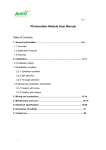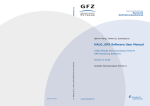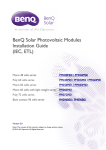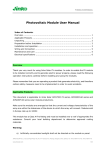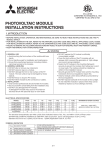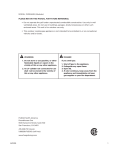Download Bolt VS-260P User manual
Transcript
JinkoSolar Photovoltaic Module User Manual (UL1703) Contents 1 General Information 1.1 Overview 1 2 1.2 Applicable Products 1.3 Warnings 2 3 2. Installation 5 2.1 Installation safety 2.3.1 Fixation with screws 5 6 6 7 7 8 9 2.3.2 Fixation with clamps 10 3 Wiring and connection 11 4 Maintenance and care 13 5 Electrical specification 13 6 Disclaimer of Liability 14 7 Contact us 16 2.2 Installation Condition 2.2.1 Climate condition 2.2.2 Site selection 2.2.3 Tilt angle selection 2.3 Mechanical Installation introduction Edition 02/2014 1. General Information 1.1 Overview Thanks for choosing Jinko Solar PV modules. In order to ensure the PV modules to be installed correctly, please read the following operation instructions carefully before modules installed and used. Please remember that the products would generate electricity and certain safety measures need to be taken to avoid danger. 1.2 Applicable Products This document is applicable to the series of solar module as listed below: UL1000V: JKMxxxP-72 (xxx=250-305, in increment of 5) JKMxxxM-72 (xxx=250-310, in increment of 5) JKMxxxP-60(xxx=200-255, in increment of 5) JKMxxxM-60(xxx=200-255, in increment of 5) UL600V: JKMxxxP-72 (xxx=250-305, in increment of 5) JKMxxxM-72 (xxx=250-310, in increment of 5) JKMxxxP-60(xxx=200-255, in increment of 5) JKMxxxM-60(xxx=200-255, in increment of 5) Make sure the array of modules installed with the Maximum permitted system voltage and the rating current and voltage of the sub-equipments such as regulators and 1 inverters. The maximum permitted system voltage (DC) of the modules(UL 1000V series) sold in America and Canada is 1000V. And the maximum permitted system voltage (DC) of the modules (UL 600V series) sold in America and Canada is 600V. This module has a Class C Fire Rating and must be installed over a roof which is with appropriate fire resistance. Before mounting the module, please consult your local building department to determine approved roofing materials. The modules are qualified for application class A, and modules qualified for safety through UL1703 within this application class are considered to meet the requirements of Safety Class II 1.3 Warnings PV modules generate DC electrical energy when exposed to sunlight or other light sources. Active parts of module such as terminals can result in burns, sparks, and lethal shock Artificially concentrated sunlight shall not be directed on the module or panel. Front protective glass is utilized on module. Broken solar module glass is an electrical safety hazard (electric shock and fire). These modules cannot be repaired and should be replaced immediately. Warning 2 Electric Shock and Burn Hazard This photovoltaic module produces Electricity when exposed to the sun Rev. C 3 To reduce the risk of electrical shocks or burns, modules may be covered with an opaque material during installation to avoid shocks or burns. The fire rating of this module is valid only when mounted in the manner specified in the mechanical mounting instructions. The module is considered to be in compliance with UL 1703 only when the module is mounted in the manner specified by the mounting instructions below. All installations must be performed in compliance with the National Electrical Code (NEC) and modules installed in Canada need to follow Canadian electric code. A module with exposed conductive parts is considered to be in compliance with UL 1703 only when it is electrically grounded in accordance with the instructions presented below and the requirements of the National Electrical Code. Any module without a frame (laminate) shall not be considered to comply with the requirements of UL 1703 unless the module is mounted with hardware that has been tested and evaluated with the module under this standard or by a field Inspection certifying that the installed module complies with the requirements of UL 1703. The installation work of the PV array can only be done under the protection of sun-sheltering covers or sunshades and only qualified person can install or perform maintenance work on this module. Follow the battery manufacture„s recommendations if batteries are used with module Do not use this module to replace or partly replace roofs and walls of living buildings. Do not install modules where flammable gas may be present. Do not touch live terminals with bare hands. Use insulated tools for electrical connections. Do not remove any part installed by Jinko Solar or disassemble the module. 4 All instructions should be read and understood before attempting to install, wire, operate and maintain the module. Please don‟t lift up PV modules using the attached cables or the junction box. All PV systems must be earthed. If there is no special regulation, please follow the National Electrical Code or other national code. Common hardware items such as nuts, bolts, star washers, lock washers and the like have not been evaluated for electrical conductivity or for use as grounding devices and should be used only for maintaining mechanical connections and holding electrical grounding devices in the proper position for electrical conductivity. Such devices, where supplied with the module and evaluated through the requirements in UL 1703, may be used for grounding connections in accordance with the instructions provided with the module. Under normal conditions, a photovoltaic module is likely to experience conditions that produce more current and/or voltage than reported at standard test conditions. The requirements of the National Electrical Code (NEC) in Article 690 shall be followed to address these increased outputs. In installations not under the requirements of the NEC, the value of Isc and Voc marked on this module should be multiplied by a factor of 1.25 when determining component voltage ratings, conductor ampacities, overcurrent device ratings, and size of controls connected to the PV output. Once the PV module has been shipped to the installation site, all of the parts should be unpacked properly with care. Do not stand or step on the PV module like below pictures show, this is prohibited and .there is a risk of damage the module and cause injury for you. Only PV modules with the same cell size should be connected in series. During all transportation situations, please make sure no huge shock for the vehicle or the modules, as this may damage the module or lead the cell to be crack. During all transportation situation, never let the module fall down from the vehicle, house or hands. This will break the cells of the modules. Do not clean the glass with chemicals. Rev. C Do not disconnect any of the modules when it is under load. 2. Installation 2.1 Installation safety 5 Always wear protective head gear, insulating gloves and safety shoes (with rubber soles). Keep the PV module packed in the carton until installation. Do not touch the PV module unnecessarily during installation. The glass surface and the frame may be hot. There is a risk of burns and electric shock. Do not work in rain, snow or windy conditions. Due to the risk of electrical shock, do not perform any work if the terminals of the PV module are wet. Use insulated tools and do not use wet tools. When installing PV modules, do not drop any objects (e.g., PV modules or tools). Make sure flammable gasses are not generated or present near the installation site. Insert interconnect connectors fully and correctly. Check all connections. The interconnect cable should be securely fastened to the module frame, Cable support should be done in a way to avoid the connector from scratching or impacting the back sheet of the module. Do not touch the terminal box and the end of the interconnect cables (connectors) with bare hands during installation or under sunlight, regardless of whether the PV module is connected to or disconnect from the system. Do not expose the PV module to excessive loads on the surface of the PV module or twist the frame. Do not hit or put excessive load on the glass or back sheet, this may break the Cells or cause micro crack. During the operation, don‟t use sharp tools to wipe the back sheet and glass, it would leave scratch on the module. Do not drill holes on the frame, it may cause corrosion of the frame. For roof mounting structure, when install the modules, please try to follow the “from top to bottom” and/or “from left to right” principle, and don‟t step on the module, that will damage the module and would be dangerous for personal safety. 2.2 Installation Condition 2.2.1 Climate condition Please install the modules in the following conditions: a) Operating temperature: within –40°C(-4°F) to 85°C (185°F) b) Relative humidity: within 45% to 95%. ﹡Note: The mechanical load bearing (include wind and snow loads) of the module is based on the mounting methods. The professional system installer must be responsible for mechanical load calculation according to the system design. 2.2.2 Site selection In most applications, Jinko solar PV modules should be installed in a location where they will receive maximum sunlight throughout the year. In the Northern Hemisphere, the module should typically face south, and in the Southern Hemisphere, the modules should typically face north. Modules facing 30 degrees away from true South (or North) will lose approximately 10 to 15 percent of their power output. If the module faces 60 degrees away from true South (or North), the power loss will be 20 to 30 percent. When choosing a site, avoid trees, buildings or obstructions, which could cast shadows on the solar photovoltaic modules especially during the winter months when the arc of the sun is lowest over the horizon. Shading causes loss of output, even though the factory fitted bypass diodes of the PV module will minimize any such loss. Do not install the PV module near naked flame or flammable materials. 6 Rev. C When solar modules are used to charge batteries, the battery must be installed in a manner, which will protect the performance of the system and the safety of its users. Follow the battery manufacturer‟s guidelines concerning installation, operation and maintenance recommendations. In general, the battery (or battery bank) should be away from the main flow of people and animal traffic. Select a battery site that is protected from sunlight, rain, snow, debris, and is well ventilated. Most batteries generate hydrogen gas when charging, which can be explosive. Do not light matches or create sparks near the battery bank. When a battery is installed outdoors, it should be placed in an insulated and ventilated battery case specifically designed for the purpose. Do not install the PV module in a location where it would be immersed in water or continually exposed to water from a sprinkler or fountain etc. 2.2.3 Tilt angle selection The tilt angle of the PV module is measured between the surface of the PV module and a horizontal ground surface (Figure 1). The PV module generates maximum output power when it faces the sun directly. Figure1: PV module title angle For standalone systems with batteries where the PV modules are attached to a permanent structure, the tilt angle of the PV modules should be selected to optimize the performance based on seasonal load and sunlight. In general, if the PV output is adequate when irradiance is low (e.g., winter), then the angle chosen should be adequate during the rest of the year. For grid-connected installations where the PV 7 modules are attached to a permanent structure, PV modules should be tilted so that the energy production from the PV modules will be maximized on an annual basis. 2.3 Mechanical Installation introduction Solar PV modules usually can be mounted by using the following methods: screws and clamps. ﹡Note: 1) All installation methods herein are only for reference, and Jinko solar will not provide related mounting components, the system installer or trained professional personnel must be responsible for the PV system‟s design, installation, and mechanical load calculation and security of the system. 2) Before installing, you should confirm below important things: 1) Visual check before installation, to make sure there is no bug in the packing and junction box as well as the surface of module, If have , remove and clean it . 2) Check the series number is right or not. 3) Jinko modules are designed to meet a maximum positive (or upward) pressure of 3600Pa and negative (or downward,) pressure of 1600Pa. When mounting modules in snow-prone or high-wind environments, Special care should be taken to mount the modules in a manner that provides sufficient design strength while meeting local code requirements 2.3.1 Fixation with screws The frame of each module has 8 mounting holes (Length* Width: 14mm*9mm) used to secure the modules to support structure. You can use the four symmetry holes close to the inner side on module frame. If excessive wind or snow load are expected, you must use all the eight mounting holes. The module frame must be attached to a mounting rail using M8 corrosion-proof screws together with spring washers and flat washers in eight symmetrical locations on the PV module. The applied torque should be big enough to fix it steadily. Please find detailed mounting information in the below illustration, 8 Rev. C Figure 2 above: PV module installed with Screw fitting method* 2.3.2 Fixation with clamps The applicable products only allow using clamps at long side of frames. The module clamps should not come into contact with the front glass and must not deform the frame. Be sure to avoid shadowing effects from the module clamps. The module frame is not to be modified under any circumstances. When choosing this type of clamp-mounting method, please be sure to use at least four clamps on each module, two clamps should be attached on each long side of the module. The applied torque should be big enough to fix it steadily(about 8 N-m), for safety, you‟d better follow the clamps manufacture‟s recommendation. Please find detailed mounting information in the below illustration, the mounting place distance is suggested bigger than J and less than K,as showed below. 9 Figure3 above: PV module installed at long side with Clamp fitting method Dimension(mm) Cell Module type Cell type quantity A*B J K M O N P JKMXXXP-72 Poly 6*12 1956*992 400 480 5~11 0.5~2mm ≥14 >2mm JKMXXXM-72 Moly 6*12 1956*992 400 480 5~11 0.5~2mm ≥14 >2mm JKMXXXP-60 Poly 6*10 1650*992 400 420 5~10 0.5~2mm ≥14 >2mm JKMXXXM-60 Moly 6*10 1650*992 400 420 5~10 0.5~2mm ≥14 >2mm Table 1 above: Mechanical dimensions when modules installed at long side with Clamp 10 Rev. C 3. Wiring and connection a) Before this procedure, please read the operation instructions of the PV system carefully. Make wiring by Multi-connecting cables between the PV modules in series or parallel connection, which is determined by user‟s configuration requirement for system power, current and voltage. b) PV module connected in series should have similar current. Modules must not be connected together to create a voltage higher than the permitted system voltage(1000VDC), as reference the maximum number of modules in series (N) can be easily calculated by dividing the Maximum System Voltage of the modules by the respective Voc value of the module. Any more please always take into consideration the variation of the voltage under different temperatures, the Voc of the modules will be rise when the temperature drops. For example: with JKM290M-72 modules (Max. System voltage is 1000V) the maximum series modules configuration number should NEVER can exceed N= 21 (1000V/45.7V = 21.8) c) PV module connect in parallel should have similar voltage. As reference the maximum number of modules in parallel (M) can be easily calculated by dividing the maximum rated current (indicated in the electrical specification below) by Isc value of the module, and then plus 1. Any more please always take into consideration the variation of the current under different temperatures, the Isc of the modules will be rise when the temperature goes up. d) Open the connection box of the control system and connect the cabled from the PV arrays to the connection box in accordance with the installation indication of the PV control systems. The cross-sectional area and cable connector capacity must satisfy the maximum short-circuit of PV system (For a single component, we recommended the cross-sectional area of cables is 4mm2 and the rated current of connectors is more than 10A), otherwise cables and connectors will become overheating for large current. Please pay attention: the temperature limit of cables is 85℃ and the temperature limit of connector 105℃ e) All module frames and mounting racks must be properly grounded in accordance with local and national electrical codes. It is recommended that the applied torque is 2.3 to 2.8N.m. 11 Jinko modules can be grounded using third party ground washers or clip devices ( JKMXXXM-72 , JKMXXXP-72 , JKMXXXM-60 , JKMXXXP-60 Use Tyco : 1954381-1;)as long as the products are approved for grounding metallic frames of PV modules. Alternate grounding options built into the racking system are acceptable so long as they have been UL approved. f) Follow the requirements of applicable local and national electrical codes. g)These modules contain factory installed bypass diode .if these modules are incorrectly connected to each other, the bypass diodes, cable or junction box may be damaged. h) The module shall wire in accordance with the NEC, the grounding method of the frame of arrays shall comply with the NEC, article 250. i) It is recommended that the screw be tightened to a torque of about 8 Nm. j) The cable of the junction box is defined as L1, as showed below. For Jinko standard module, L1 is 900 /1200mm; and for customized module, L1 can be based on your condition, take the cable length into consideration before designing the wiring layout. 4. Maintenance and care a) A built up of dust or dirt on the module(s) front face will result in a decreased energy output. Clean the panel(s) preferably once per annum if possible (depend on site conditions) using a soft cloth dry or damp, as necessary. b) Never use abrasive material under any circumstances. c) Examine the PV module(s) for signs of deterioration. Check all wiring for possible rodent damage, weathering and that all connections are tight and corrosion free. Check electrical leakage to ground. d) Check fixing screws and mounting brackets are tight, adjust and tighten as necessary. 12 Rev. C e) Check the junction box and diodes are well. If you have any diodes problem, please contact the manufacturer. f ) When clean the modules, it is not allowed to stand on the module or the likes. Like below pictures show, this it prohibited. 5. Electrical specification The module electrical rating are measured under Standard Test Conditions, which are 1000W/m2, irradiance with AM 1.5 spectrum and 25 deg (77°F) ambient temperature. The module might produce more or less voltage or current than rating value in uncertainty condition. Accordingly, the values of ISC and VOC marked on the module should be multiplied by a factor of 1.25 when determining component voltage ratings, conductor current ratings, fuse sizes, and size of controls connected to the PV output. The corresponding electrical specification can be downloaded from website www.jinkosolar.com. 13 6. Disclaimer of Liability Because the use of the manual and the conditions or methods of installation, operation, use and maintenance of photovoltaic (pv) product are beyond Jinko‟s control, Jinko does not accept responsibility and expressly disclaims liability for loss ,damage, or expense arising out of or in any way connected with such installation, operation, use or maintenance. No responsibility is assumed by Jinko for any infringement of patents or other rights of third parties, which may result from use of the PV product.. NO license is granted by implication or otherwise under any patent or patent rights. The information in this manual is based on Jinko‟s knowledge and experience and is believed to be reliable, but such information including product specification(without limitations)and suggestions do not constitute a warranty, expresses or implied .Jinko reserve the right to change the manual, the PV produce, the specifications, or product information sheets without prior notice. 14 Rev. C Note 15 7. Contact us Jinko Solar Co., Ltd. (Shanghai Office) 16F, Building No.2, 428# South Yang Gao Road, Shanghai, China Postcode: 200127 Tel :(86)-21-60611781 Fax :(86)-21-68761115 Jinko Solar Co., Ltd. (Jiangxi Manufacture base) No.1 Jingko Road, Shangrao Economic Development Zone, Jiangxi Province, China Postcode: 334100 Tel:(86)-793-8588188 Fax:(86)-793-8461152 Jinko solar Import and Export co., LTD Xuri District, Shangrao Economic Development Zone, Jiangxi Province, CHINA Postcode: 334100 Tel: +86-793-8618987 Fax: +86-793-8461152 Customer Service:[email protected] Jinko Solar USA 343 Sansome Street, Suite 975, San Francisco, CA 94104 Tel:+(415) 402 0502 Fax: +(415) 402 0703 [email protected] Jinko Solar Canada Co., Ltd. Suite 703, 100 Allsate Parkway, Markham,ON Canada L3R 6H3 Tel:+1 905 604 2527 Fax: +1 905 604 2687 [email protected] 16 Global Sales & Marketing Center Jiangxi Manufacture Base Zhejiang Manufacture Base 16F, Building No.2 No.1 Jinko Road, No.58 Yuanxi Road, 428# South Yang Gao Road, Shangrao Economic Development Zone, Haining Yuanhua Industrial Park, Shanghai, China 200127 Jiangxi Province, China 334100 Zhejiang Province, China 314416 Tel: +86 21 6061 1799 Tel:+86 793 858 8188 Tel: +86 573 8798 5678 Fax: +86 21 6876 1115 Fax:+86 793 846 1152 Fax: +86 573 8787 1070 www.jinkosolar.com | Technic Support: [email protected] | After-sales: [email protected]




















